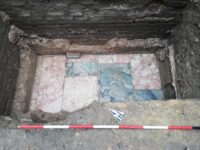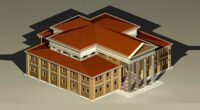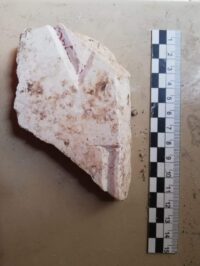 The remains of a large, luxurious public building from the Roman era have been unearthed in the northern Italian city of Fano. Located just opposite the ancient city’s forum, the remains consist of at least five rooms with more than six feet of the walls’ height preserved. The walls are five feet thick and coated in lime mortar. Marble slabs decorate the sides. The floors are also adorned with large slabs of expensive imported marble in green and pink.
The remains of a large, luxurious public building from the Roman era have been unearthed in the northern Italian city of Fano. Located just opposite the ancient city’s forum, the remains consist of at least five rooms with more than six feet of the walls’ height preserved. The walls are five feet thick and coated in lime mortar. Marble slabs decorate the sides. The floors are also adorned with large slabs of expensive imported marble in green and pink.
The building dates to around 2,000 years ago. A fragment of an inscription that still bears traces of its original rubrication (the red pigment rubbed into the letters to make them stand out against the marble) was found. Only two letters are preserved on the fragment: a V on one line and an I on the line below it.
The location across from the site of the ancient forum, the scale of construction and the richness of the marble inlays of the floor and walls mark it as a major Roman public building of the Augustan era (1st c. B.C. – 1st. c. A.D.) There’s even an outside chance that this is the much-sought Basilica of Vitruvius, a civic building designed and constructed by the 1st century B.C. architect, military engineer and author of the seminal treatise De Architectura.
 Vitruvius, who served under Julius Caesar in the 50s and late 40s century B.C., wrote De Architectura in the 20s B.C. It is considered the first book on architectural theory and is the only one from antiquity to survive today. After its rediscovery and publication in 1486, it became the primary reference for European Renaissance architects. In all ten books of the treatise, Vitruvius records only one building that he designed and executed personally: the Basilica of Fano, completed in 19 B.C. in what was then the Roman city of Fanum Fortunae (named after a now-lost temple of Fortune). It was located at a strategic trade junction where the Via Flaminia met the Adriatic and was an important urban center worthy of the innovative architectural grandeur of the Vitruvius’ basilica. In Book V.1.6-10, Vitruvius describes the basilica, listing its features and measurements in detail and extolling its distinctive proportions and symmetry which were markedly different from the typical Roman basilica of his time.
Vitruvius, who served under Julius Caesar in the 50s and late 40s century B.C., wrote De Architectura in the 20s B.C. It is considered the first book on architectural theory and is the only one from antiquity to survive today. After its rediscovery and publication in 1486, it became the primary reference for European Renaissance architects. In all ten books of the treatise, Vitruvius records only one building that he designed and executed personally: the Basilica of Fano, completed in 19 B.C. in what was then the Roman city of Fanum Fortunae (named after a now-lost temple of Fortune). It was located at a strategic trade junction where the Via Flaminia met the Adriatic and was an important urban center worthy of the innovative architectural grandeur of the Vitruvius’ basilica. In Book V.1.6-10, Vitruvius describes the basilica, listing its features and measurements in detail and extolling its distinctive proportions and symmetry which were markedly different from the typical Roman basilica of his time.
 It was destroyed in the Gothic invasion of Fanum Fortunae in 540 A.D. Architects and artists have been recreating it in illustrations and models since the 15th century and many attempts have been made to find archaeological traces of the basilica to no avail. Chances are, this will be another false alarm, and even if it is a real candidate, getting firm evidence either way will be extremely challenging.
It was destroyed in the Gothic invasion of Fanum Fortunae in 540 A.D. Architects and artists have been recreating it in illustrations and models since the 15th century and many attempts have been made to find archaeological traces of the basilica to no avail. Chances are, this will be another false alarm, and even if it is a real candidate, getting firm evidence either way will be extremely challenging.
Excavation of the site will continue as soon as funds can be secured. A 2021 geophysical scan of the whole street, felicitously named Via Vitruvio, found indications of numerous walled spaces of different forms and dimensions under the street, but they are likely from various different eras, not a single Roman building.